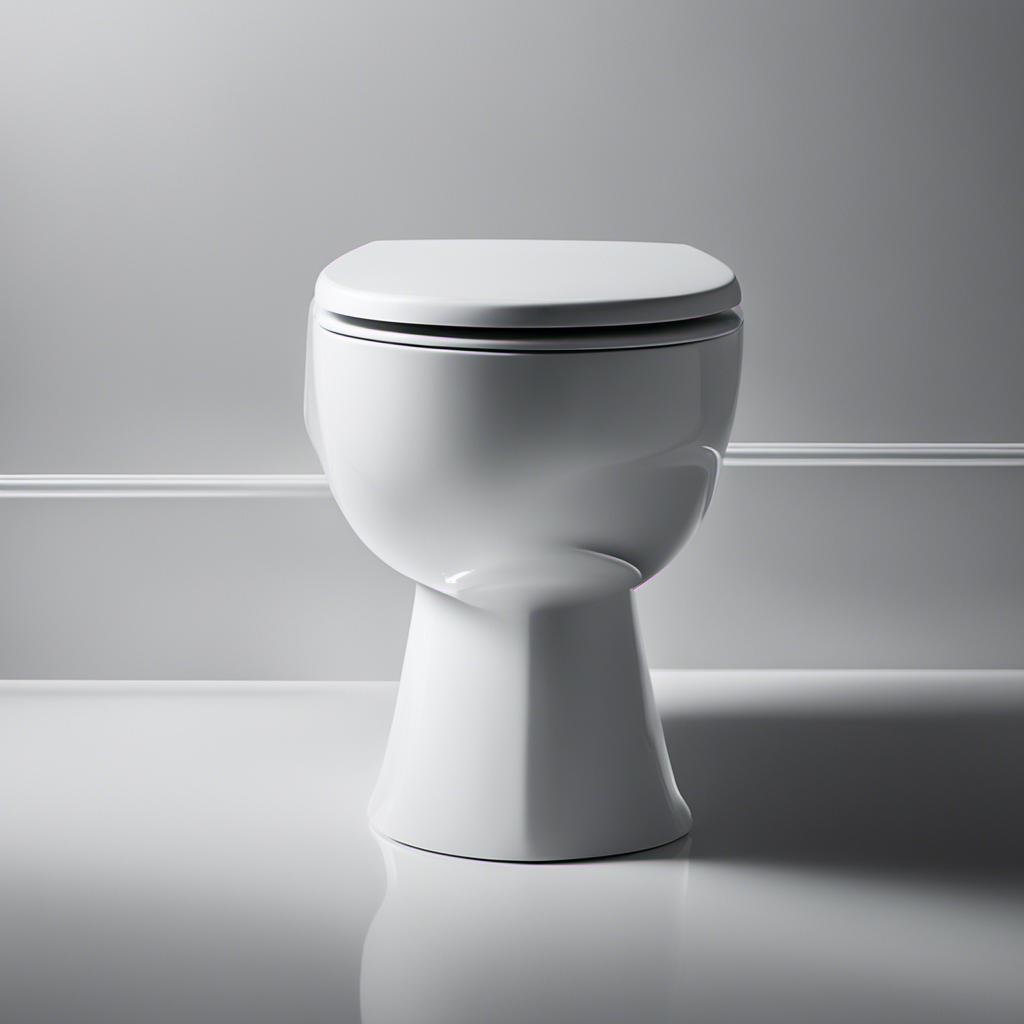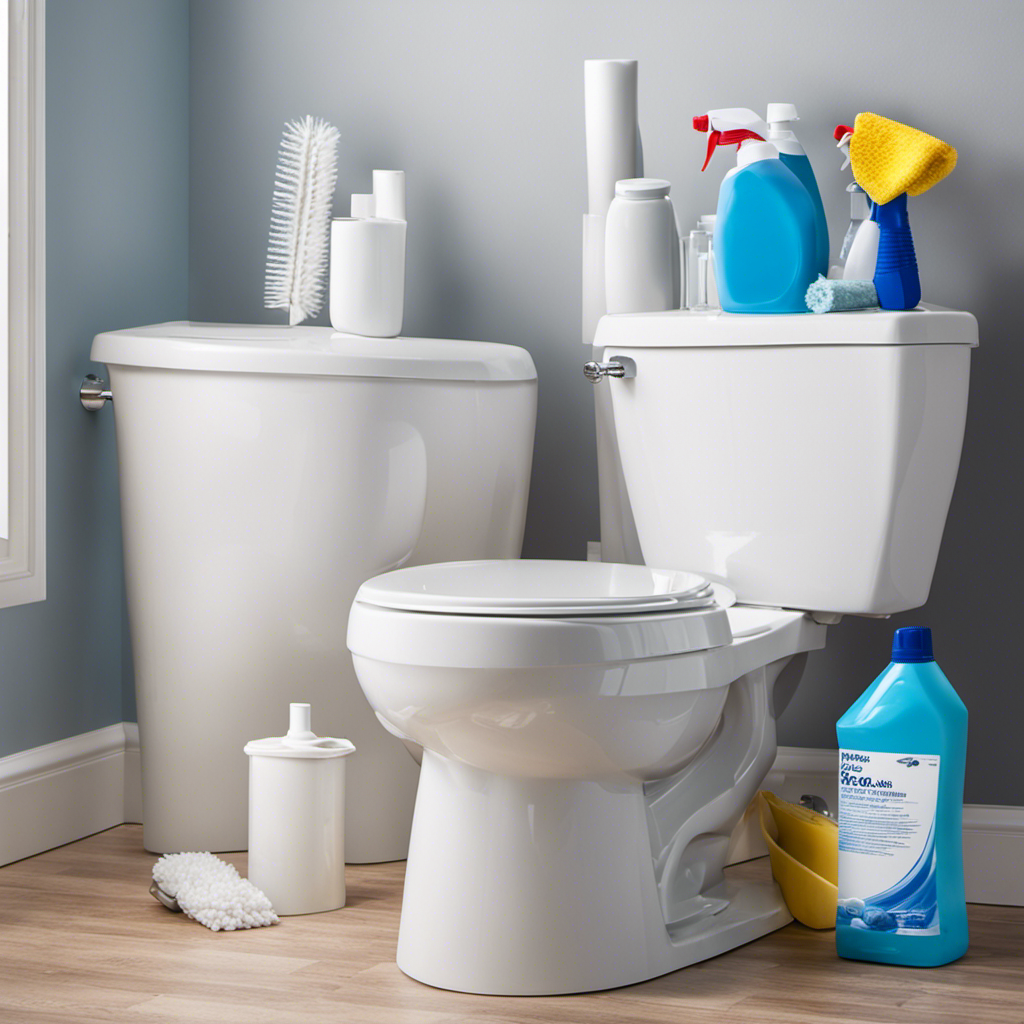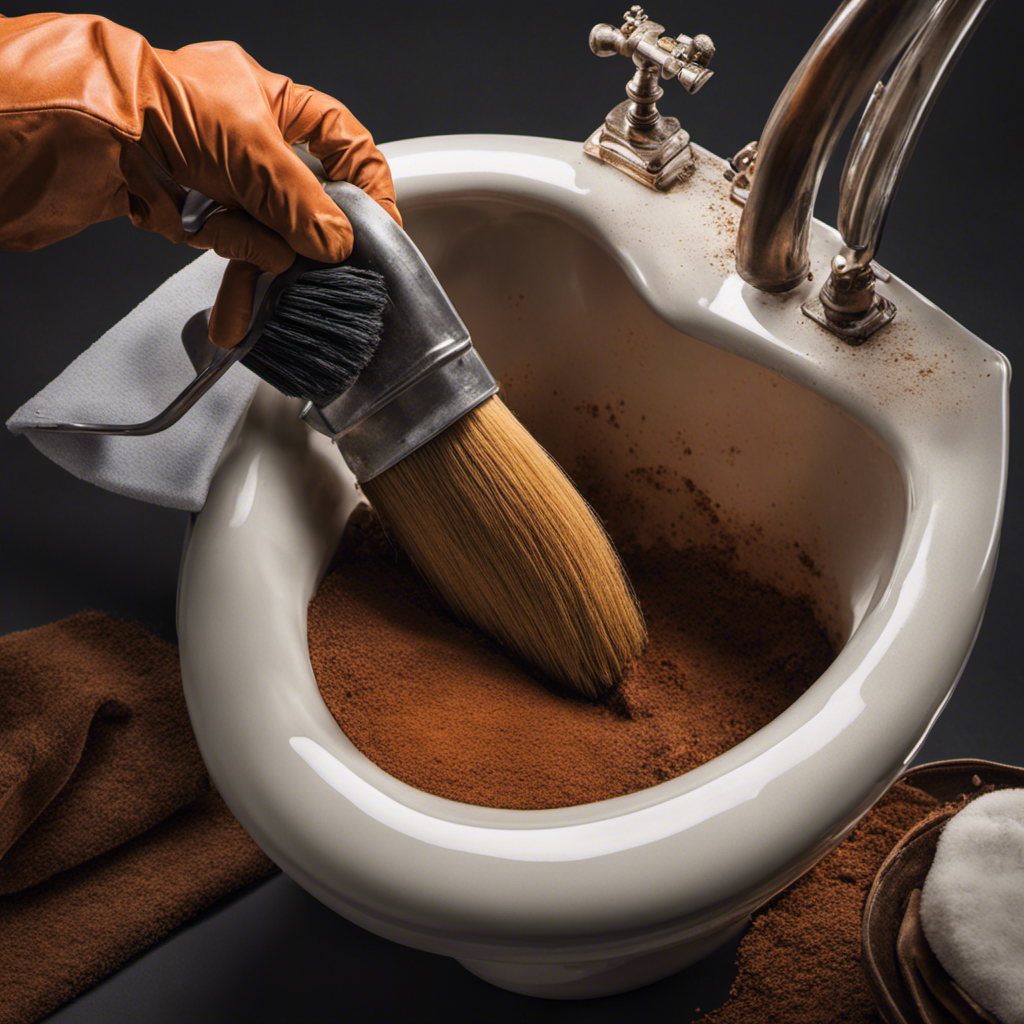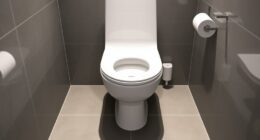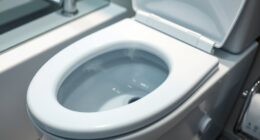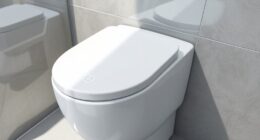Boosting toilet flush power can be a bothersome task, but with a few tips and considerations, it can be easily accomplished.
This article provides practical advice on how to increase the effectiveness of your toilet flush.
From adjusting the toilet tank float to cleaning the siphon and rim jets, these tips are designed to optimize your flushing experience.
Whether you’re considering changing toilet parts or exploring alternative solutions, this article has got you covered.
Get ready to say goodbye to weak flushes and hello to a powerful and efficient toilet.
Key Takeaways
- Increasing toilet flush power can be achieved by adjusting the toilet tank float, checking for leaks, repositioning the cylinder float, and cleaning the siphon and rim jets.
- If changing toilet parts is necessary, options include replacing the fill valve with a more powerful one, replacing the flush valve, using bleach or vinegar and baking soda to clear clogs and deposits, or installing a new high-pressure toilet.
- Low-flow toilets have lower water consumption and are more environmentally friendly, while high-flow toilets consume more water but often require only one flush.
- Before attempting to increase flush power, it is important to consider the cost, environmental impact, and whether it is necessary if the toilet is functioning properly.
Increasing Toilet Flush Power
To increase toilet flush power, homeowners can try adjusting the tank float, checking for leaks, cleaning the siphon and rim jets, and using a plunger or drain snake if necessary.
Adjusting the tank float allows more gallons of water to enter the bowl, increasing toilet water pressure and improving flushing efficiency.
Checking for leaks in the toilet tank, hoses, valves, pipes, and other elements is crucial as leaks can affect flush power.
Cleaning the siphon and rim jets removes any clogs or build-up that may hinder the flushing process.
If necessary, using a plunger or drain snake can help unclog the toilet and restore proper flush power.
Changing Toilet Parts
Replacing the fill valve with a more powerful one, such as the Fluidmaster valve, can improve the flushing performance of the toilet. Upgrading toilet parts can offer several benefits.
By upgrading the fill valve, you can increase the water flow and pressure, resulting in a more efficient flush. The Fluidmaster valve, in particular, is known for its reliability and durability. It is designed to provide a consistent and powerful flush, ensuring that waste is effectively removed from the bowl.
However, it is important to consider the pros and cons of different toilet valve options. While a more powerful fill valve can enhance flushing performance, it may also lead to higher water consumption and increased water bills.
Therefore, it is essential to weigh the benefits against the potential drawbacks before making a decision.
Differences Between Low-Flow and High-Flow Toilets
Low-flow toilets have a lower water consumption and gallons per flush (GPF) ratio, while high-flow toilets consume more water.
Advantages of Low-Flow Toilets:
- Lower water consumption reduces water bills and conserves water resources.
- Wider flush valves allow for more efficient waste removal.
- Outlet placement closer to the bottom of the bowl enhances gravity-assisted flushing.
- Modern low-flow toilets are designed to balance environmental concerns and flushing power.
Disadvantages of High-Flow Toilets:
- Increased water consumption leads to higher water bills and less eco-friendly operation.
- Users may need to flush low-flow toilets twice, while high-flow toilets usually require only one flush.
- Higher water flow can cause excessive splashing and noise during flushing.
- Environmental impact is a concern due to the excessive consumption of water resources.
Overall, low-flow toilets provide advantages in terms of water conservation and efficient waste removal, while high-flow toilets have disadvantages in terms of increased water consumption and negative environmental impact.
Considerations for Increasing Flush Power
Increasing the efficiency of the toilet’s flushing mechanism may require adjusting the water level or cleaning the siphon and rim jets.
When considering ways to increase flush power, it is important to take into account toilet water consumption and flushing efficiency.
High-flow toilets consume more water, resulting in higher water bills and a lesser environmental impact. However, low-flow toilets, while more environmentally friendly, may require multiple flushes to effectively remove waste.
Before attempting to increase flush power, it is crucial to assess whether the toilet is functioning properly.
Additionally, it is important to consider the cost and environmental implications of increasing flush power.
Alternative solutions, such as using bleach or vinegar and baking soda for cleaning and maintenance, should also be considered.
Consulting professional plumbers and manufacturer’s manuals can provide additional guidance.
Alternative Solutions
Using household cleaners like bleach, vinegar, and baking soda can help maintain a clean and odor-free toilet bowl.
When it comes to toilet cleaning, many people wonder whether bleach or vinegar is more effective. Bleach is a powerful disinfectant that can effectively kill germs and bacteria in the toilet bowl. On the other hand, vinegar is a natural cleaner that can help remove stains and mineral deposits.
Both bleach and vinegar have their advantages, so it ultimately depends on personal preference and the specific cleaning needs of the toilet.
As for toilet bowl deodorizers, they can be effective in masking odors temporarily, but they do not address the root cause of the smell. To truly eliminate odors, regular cleaning and proper ventilation are essential.
The Importance of Regular Maintenance
Regular maintenance is crucial for ensuring the optimal performance and longevity of a toilet. There are both benefits to professional maintenance and DIY maintenance tips that can help keep a toilet functioning at its best.
Professional maintenance offers the advantage of trained experts who can identify and fix any potential issues, ensuring that the toilet operates efficiently. They can also provide regular inspections and cleanings to prevent any major problems from arising.
On the other hand, DIY maintenance tips include tasks such as regularly checking for leaks, cleaning the toilet siphon and rim jets, and unclogging the toilet using a plunger or drain snake. These simple tasks can help prevent major issues and keep the toilet in good working order.
Expert Advice: Tips From Plumbers and Homeowners
Plumbers and homeowners offer valuable advice for optimizing toilet performance and ensuring long-lasting functionality. Here are some plumbing hacks and troubleshooting tips to boost toilet flush power:
- Adjust the toilet tank float to allow for more water to enter the bowl.
- Check for leaks and replace faulty parts.
- Reposition the cylinder float to the correct height.
- Clean the toilet siphon and rim jets to remove clogs or build-up.
- Use a plunger or drain snake to unclog the toilet if needed.
These tips can help improve the flush power of your toilet and prevent common issues. However, it’s important to consider the differences between low-flow and high-flow toilets, as well as the environmental impact and potential increase in water consumption.
If all else fails, consulting professionals and following manufacturer instructions can provide additional guidance. Remember, regular maintenance and cleaning are key to maintaining optimal toilet performance.
Final Thoughts: Cost and Environmental Impact
Installing a new, high-pressure toilet may be a last resort option to improve flush performance. However, it is important to weigh the cost and environmental impact before making a decision.
High-pressure toilets consume more water and are less environmentally friendly compared to low-flow toilets. While they may provide stronger flushing power, users often have to flush low-flow toilets multiple times, while high-flow toilets typically require only one flush. This increased water consumption can lead to higher water bills.
Additionally, low-flow toilets are designed with water conservation in mind. They have wider flush valves and better gravity-assisted flushing. Before opting for a high-pressure toilet, it is important to consider the cost effectiveness and environmental impact.
Regular maintenance and cleaning can also help improve the performance of any toilet without the need for a high-pressure option.
Frequently Asked Questions
How Do I Know if My Toilet Needs More Flush Power?
If the toilet flush seems weak, signs of a weak flush include water not fully draining from the bowl or multiple flushes needed. Troubleshoot by checking for clogs, leaks, or faulty parts.
Can I Increase the Flush Power of My Low-Flow Toilet Without Replacing It?
Yes, the flush power of a low-flow toilet can be increased without replacing it. Techniques such as adjusting the tank float, cleaning siphons and rim jets, and using vinegar can improve toilet efficiency and increase water pressure.
What Should I Do if My Toilet Has a Weak Flush Even After Trying the Suggested Methods?
If a toilet has a weak flush even after trying suggested methods for increasing flush power, troubleshooting weak flush is recommended. This may involve checking for leaks, cleaning siphons and jets, or replacing faulty parts.
Are There Any Drawbacks to Increasing the Flush Power of a Toilet?
Increasing flush power can have drawbacks. High-pressure flush systems consume more water and may lead to higher water bills. Low-flow toilets are more environmentally friendly and efficient. Consider the cost and environmental impact before increasing flush power.
What Are Some Signs That Indicate It’s Time to Replace the Toilet Instead of Trying to Increase the Flush Power?
Toilet replacement signs include frequent clogging, leaks, cracks, and outdated design. Indicators of low flush power include weak flushing, incomplete waste removal, and consistent need for multiple flushes.
Conclusion
In conclusion, there are various methods and considerations for increasing toilet flush power. These include adjusting the toilet tank float, checking for leaks, and cleaning the siphon and rim jets. Changing toilet parts such as the fill valve or flush valve can also have a significant impact. It is important to consider the differences between low-flow and high-flow toilets, as well as the cost and environmental impact of increasing flush power.
For example, a homeowner in a water conservation area may opt for a low-flow toilet with multiple flushes, while a larger household may benefit from a high-flow toilet with a more powerful flush. Regular maintenance, including using bleach or vinegar and baking soda for cleaning, is crucial for optimal performance.
Consulting with plumbers and homeowners who have successfully increased flush power can provide valuable tips and advice. Ultimately, it is essential to weigh the cost and environmental impact before making any decisions.
